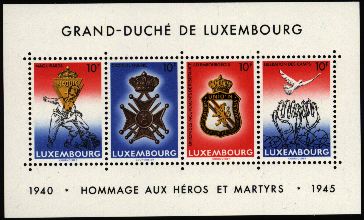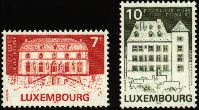
|
Luxembourg Stamps
|

|
Luxembourg Stamps
|
| March 4 | Portrait Medallions I |
| March 4 | Luxembourg Fencing Federation -- 50th Anniversary |
| March 4 | First Automobile -- Centenary |
| March 4 | Telephone -- Centenary of Telephone Service |
| March 4 | Visit of Pope John Paul II |
| May 8 | Europa 1985 -- Music |
| May 8 | World War II Armistice -- 40th Anniversary |
| September 9 | Restored Buildings -- Echternach Orangerie and Maison Mohr de Waldt |
| September 9 | Endangered Wildlife |
| September 9 | National Library |
| December 5 | Children's Portraits II (Caritas Issue) |

These stamps depict a steatite and three 16th and early 17th century medals:

The Luxembourg Fencing Federation was formed in 1935 by the merging of three small clubs in the Grand Duchy. It has organized many events, including the 1954 World Championships and the 1956 Under-21 World Selection Matches.

The first motor cars were built in 1885 in France and Belgium based on Otto's four-stroke engine. The first car introduced in Luxembourg in 1895, shown on the stamp, was a Benz-Vélo with a four-stroke single-cylinder, 1.5 horsepower gasoline engine.

The first telephone network in Luxembourg became operational on October 1, 1885. It serviced Luxembourg City and its surroundings. Over the next 10 years most of the company received telephone service.

The stamp commemorates the visit of Pope John Paul II to Luxembourg in 1985.

The Europa theme of "music" is adopted by these two stamps. The first honors the Union Grand-Duc Adolphe, an association of 264 choral, instrumental and folklore societies. The second honors the Luxembourg Music School which opened in 1984.

This souvenir sheet commemorates the 40th anniversary of the end of World War II and is a tribute to the heroes and martyrs who defended the independence of the Grand Duchy from 1940 to 1945 at the risk of their lives. The four subjects depicted are the Armed Resistance (Maquisards), a war medal, Union of Luxembourg Resistance Movements (U'NION), and the liberation of the concentration camps.

The Echternach Orangerie is a Baroque building in the former claustral garden of Echternach Abbey, built around 1750 under Abbot Horman.
The Mohr de Waldt House is a patrician dwelling built in Luxembourg towards the middle of the 17th century by Eustache de Wiltheim, president of the Provincial Council. In the 18th century this house was the residence of the Mohr de Waldt baronial family. It was acquired by the State in 1959 and has now been completely restored.

These stamps depict four protected animals which are in danger of becoming extinct:

This stamp shows an ancient binding of the Mansfeld collection kept at the National Library in Luxembourg. Mansfeld (1517-1604) was a governor of Luxembourg and had many books bound in the purest French Renaissance style with his coat of arms surrounded by the chain of the Order of the Golden Fleece.

These stamps depict the Nativity and portraits of children based on a graphic study of the physionomy of the child, the mirror of its soul: